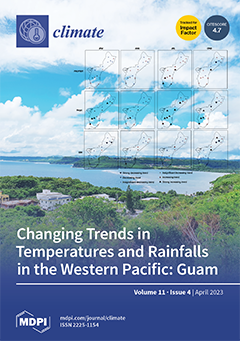In the present work, we investigate the solar radiation climate of Saudi Arabia, using solar radiation data from 43 sites in the country covering the period 2013–2021. These data include hourly values of global, G, and diffuse, G
d, horizontal irradiances from
[...] Read more.
In the present work, we investigate the solar radiation climate of Saudi Arabia, using solar radiation data from 43 sites in the country covering the period 2013–2021. These data include hourly values of global, G, and diffuse, G
d, horizontal irradiances from which the direct, G
b, horizontal irradiance is estimated. The diffuse fraction, k
d; the direct-beam fraction, k
b; and the ratio k
e = G
d/G
b, are used in the analysis. Solar maps of the annual mean G, G
d, k
d, k
b, and k
e are prepared for Saudi Arabia under all- and clear-sky conditions, which show interesting but explainable patterns. Additionally, the intra-annual and seasonal variabilities of these parameters are presented, and regression equations are provided. We find that G
b has a negative linear relationship with k
d; the same applies to G with respect to k
d or the latitude, φ, of the site. It is shown that k
d and k
b can reflect the scattering and absorption effects of the atmosphere on solar radiation, respectively; therefore, they can be used as atmospheric scattering and absorption indices. Part of the analysis considers the defined solar energy zones in Saudi Arabia.
Full article





